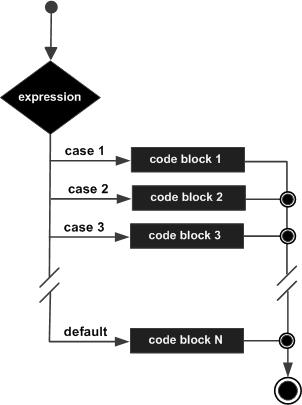
- PowerShell - Home
- PowerShell - Overview
- PowerShell - Environment Setup
- PowerShell - Cmdlets
- PowerShell - Files and Folders
- PowerShell - Dates and Timers
- PowerShell - Files I/O
- PowerShell - Advanced Cmdlets
- PowerShell - Scripting
- PowerShell - Special Variables
- PowerShell - Operators
- PowerShell - Looping
- PowerShell - Conditions
- PowerShell - Array
- PowerShell - Hashtables
- PowerShell - Regex
- PowerShell - Backtick
- PowerShell - Brackets
- PowerShell - Alias
- PowerShell Useful Resources
- PowerShell - Quick Guide
- PowerShell - Useful Resources
- PowerShell - Discussion
Powershell - Switch Statement
A switch statement allows a variable to be tested for equality against a list of values. Each value is called a case, and the variable being switched on is checked for each case.
Syntax
The syntax of enhanced for loop is −
switch(<test-value>) {
<condition> {<action>}
break; // optional
<condition> {<action>}
break; // optional
<condition> {<action>}
break; // optional
}
The following rules apply to a switch statement −
The variable used in a switch statement can only be any object or an array of objects.
You can have any number of case statements within a switch. Each case is followed by optional action to be performed.
The value for a case must be the same data type as the variable in the switch and it must be a constant or a literal.
When the variable being switched on is equal to a case, the statements following that case will execute until a break statement is reached.
When a break statement is reached, the switch terminates, and the flow of control jumps to the next line following the switch statement.
Not every case needs to contain a break. If no break appears, the flow of control will fall through to subsequent cases until a break is reached.
Flow Diagram

Example 1
Example of Switch statment without break statment.
switch(3){
1 {"One"}
2 {"Two"}
3 {"Three"}
4 {"Four"}
3 {"Three Again"}
}
This will produce the following result −
Output
Three Three Again
Example 2
Example of Switch statment with break statment.
switch(3){
1 {"One"}
2 {"Two"}
3 {"Three"; break }
4 {"Four"}
3 {"Three Again"}
}
This will produce the following result −
Output
Three
Example 3
Example of Switch statment with array as input.
switch(4,2){
1 {"One"}
2 {"Two"}
3 {"Three"; break }
4 {"Four"}
3 {"Three Again"}
}
This will produce the following result −
Output
Four Two